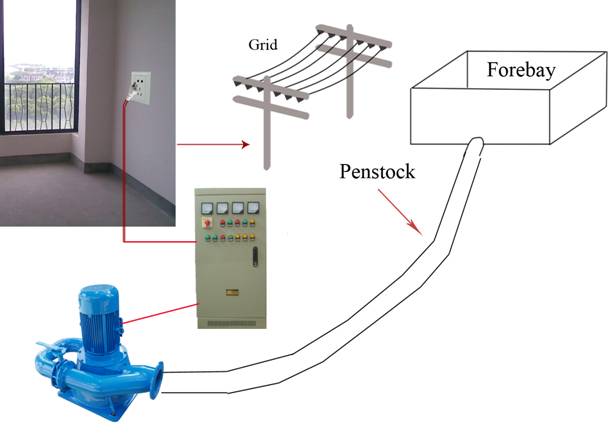|
|
|
|
 |
0086-0512-62901304 |
| 0086-0512-62901305 |
|
|
 |
0086-0512-62901305 |
|
|
 lzmjmx lzmjmx |
|
 |
lzm@yueniao.com |
| |
| zzl@yueniao.com |
| |
|
| |
alnew@yueniao.com |
|
| |

|
|
Suzhou Yueniao Machinery&Electronics Imp&Exp Co Ltd |
|
|
26KW Grid Tie Hydro Turbine Generator System
Model TA70-W26
If you have a steady source of running water, we can provide a water turbine allowing you to generate a significant proportion on your electricity needs.
The system includes hydro turbine, generator, controller. With no batteries, it connects directly to your home. When the water is running, your home is powered (or in part) by the system; when system is not working, your home is seamlessly powered by your utility as usual..
If the turbine is producing more electricity than you are using, the system will feed the surplus of the energy back to the utility. It may even spin your electric meter backwards, further reducing your monthly bill.

Water is collected upstream from the turbine and channeled in a pipe down to the turbine location. At the turbine, the water passes through a nozzle, where it accelerates, strike the turbine runner, and turn a AC three-phase alternator. Installation is very simple. Once installed there are no running costs and maintenance costs are very low.
| Item |
Parameters |
| Model |
TA70-W26 |
| Water Head Range |
60 – 70 meter |
| Water Flow Range |
35 – 45 liter/second |
| Rated Power Output |
26KW |
| Intended voltage |
Three phase, AC380V~ |
| Rotary Speed |
1500 rpm |
| Turbine runner type |
Turgo |
| Runner diameter |
340 mm |
| Number of blades |
14 |
| Number of nozzles |
1 |
| Jet diameter |
350 mm |
| Generator |
Three phase alternator |
| Power factor |
1.0 |
| Insulation level |
B/B |
| Protection level |
IP44 |
| Temperature |
-20°C~50°C |
| Humidity |
≤90% |
| Safety protection |
Short circuit, over load, Islanding, Grounding fault |
Turbine Generator |
Controller |
|

|
|
Warranty: 2 years
Claims & Return Procedures
In order to be eligible for service under this warranty, the Customer must send us pictures showing his installation of the system in a week after the installation. Professional installation is required for all water turbines.
If any problem takes place within the warranty period, Notification must be provided including a description of the alleged defect, the manner in which the water turbine was used, the serial number, and the original purchase date in addition to the name, address, and telephone number of the party requesting warranty service.
EXCLUSIONS
This warranty does not cover the following:
Equipment which has been improperly installed or modified without approval from us
Lightning damage or other “acts of God”.
Damage to product incurred during shipping
| Guide on How to Develope a Small Hydropower Plant |
HOW DOES MICRO HYDROPOWER WORK?
Hydropower plants capture the energy of falling water to generate electricity. A turbine converts
the energy of falling water into mechanical energy. Then an alternator converts the mechanical
energy from the turbine into electrical energy. The amount of electricity a hydropower plant
produces is a combination of two factors: |
1. How far the Water Falls (Head):
Generally, the distance the water falls
depends on the steepness of the terrain the water is moving across, or the height of a dam the water is stored behind. The farther the water falls, the more power it has. In fact, the power of falling water is ‘directly proportional’ to the distance it falls. In other words, water falling twice as far has twice as much energy. It is important to note we are only talking about the vertical distance the water falls – the distance the water travels horizontally is consequential only in expense of the system and friction losses. Head is usually measured in ‘meter or feet’.
2. Volume of Water Falling (Flow): More water falling through the turbine will
produce more power. The amount of water available depends on the volume of water at the source. Power is also ‘directly proportional’ to river flow, or flow volume. A river with twice the amount of flowing water as another river can produce twice as much energy. Flow volume is usually measured in ‘liter per second’, or ‘l/s’.
For Micro Hydro systems, this translates into two categories of turbines:
For high head and low flow volume sites, impulse turbines are the most efficient choice.
The power produced by an impulse turbine comes entirely from the momentum of the water hitting the turbine runners. This water creates a direct push or ‘impulse’ on the blades, and thus such turbines are called ‘impulse turbines’.
For low head and high flow volume sites, a reaction turbine is the best choice. The reaction turbine, as the name implies, is turned by reactive force rather than a direct push or impulse. The turbine blades turn in reaction to the pressure of the water falling on them. Reaction turbines can operate on heads as low as 2 feet, but require much higher flow rates than an impulse turbine. |
|
|
|